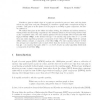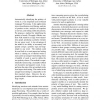335 search results - page 20 / 67 » Resolvent of large random graphs |
LATIN
2004
Springer
14 years 1 months ago
2004
Springer
Consider a game in which edges of a graph are provided a pair at a time, and the player selects one edge from each pair, attempting to construct a graph with a component as large ...
STOC
2009
ACM
14 years 8 months ago
2009
ACM
We study the topological simplification of graphs via random embeddings, leading ultimately to a reduction of the Gupta-Newman-Rabinovich-Sinclair (GNRS) L1 embedding conjecture t...
MST
2010
13 years 6 months ago
2010
Coloring a k-colorable graph using k colors (k ≥ 3) is a notoriously hard problem. Considering average case analysis allows for better results. In this work we consider the unif...
ACL
2010
13 years 5 months ago
2010
Automatically identifying the polarity of words is a very important task in Natural Language Processing. It has applications in text classification, text filtering, analysis of pr...
ESA
2009
Springer
14 years 2 months ago
2009
Springer
Finding sparse cuts is an important tool for analyzing large graphs that arise in practice, such as the web graph, online social communities, and VLSI circuits. When dealing with s...


